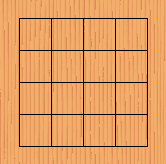 |
|
|
| Play starts on an empty board, which is a square grid of horizontal and vertical lines. This is a small one with 5x5 lines forming 25 intersections, or ``points''. The standard size is 19x19, while 9x9 is ideally suited to beginners. The object of the game is to conquer a majority of the points on the board, either by occupying or enclosing them. |
|
|
||
| The two players, Black and White, alternate in placing a stone of their color on an empty intersection. Black moves first. Stones cannot be moved, but can be captured. The unit of capture is a ``string'': a group of stones of one color that are connected along the board lines. A string is captured when it has no more adjacent empty points, or ``liberties''. Above we see four strings with 4 liberties each. | After another four moves, we again have four strings with 4 liberties each. The center point is a liberty of all strings. If black were to play there next, then the two black strings would be joined into one big string with 6 liberties, while reducing each white string to 3 liberties. Indeed, that would be the best move by far for black, but this game is to take a different course. |
|
|
||
| The next ten moves are not an example of normal play but serve to set up a position in which we can show all varieties of capture. Note that each string now has only one or two liberties. Strings with only one liberty are said to be in atari. If the opponent occupies their last liberty, they get captured. From now on we will see the players making the best possible moves. Black had better not play in the center now as the resulting string would be in atari and get captured by white. | Instead, Black captures the white bottom string that had put itself in atari. This capture provides black 19 with the liberty it needs to exist on the board. |
|
|
||
| The center still being the most important point on the board, white wastes no time in occupying it. This puts Black's string above in atari. With the top left corner stone also in atari, White threatens to capture 2 strings at once. Black could now capture the top white stone, but White would just play another stone at the same spot to recapture four black stones! | So Black captures the other white stone and in turn puts the big white string in atari. A play by White on the middle right would now result in self-capture. (some other rulesets forbid such suicide, but there are no compelling reasons to do so.) |
|
|
||
| So White obtains another liberty by capturing at 22. Now black and white could capture back and forth in the corner till eternity (a ``ko'' situation), were it not for the ``super-ko'' rule, which states that one is forbidden to recreate an earlier board position. (This same rule prohibited White from capturing black 19 back, as that would recreate the position after Black 17.) | Black 23 captures a white stone, putting two white strings in atari. |
|
|
||
| But is then itself captured by white 24. | Note that black 25 is not forbidden, since the resulting position differs from that after black 23 by one black stone. White 26 is a clever throw-in. |
|
|
||
| The capture at 27 costs Black an important liberty, which would have allowed her to put white into atari. Now, neither side can approach the other without self atari. Unable to expand their territories, both sides now ``pass''. Passing is allowed at any time in the game. (even though it repeats the board position:-) The game is over when both sides pass consecutively. | Like stones forming strings, adjacent empty points form
empty spaces. A space having only stones of one color adjacent to it is
said to be enclosed by that side (so a single stone in the middle of
the board encloses 24 empty points:-)
Black has 11 points occupied and 4 points enclosed, for a total of 15 points. White has 7 points occupied and only 1 point enclosed, for a total of 8 points. The 2 remaining empty points border on both colors and thus remain unconquered. Black wins the game by 7 points! |
Congratulations! You have now learned the rules of this magnificent
game.